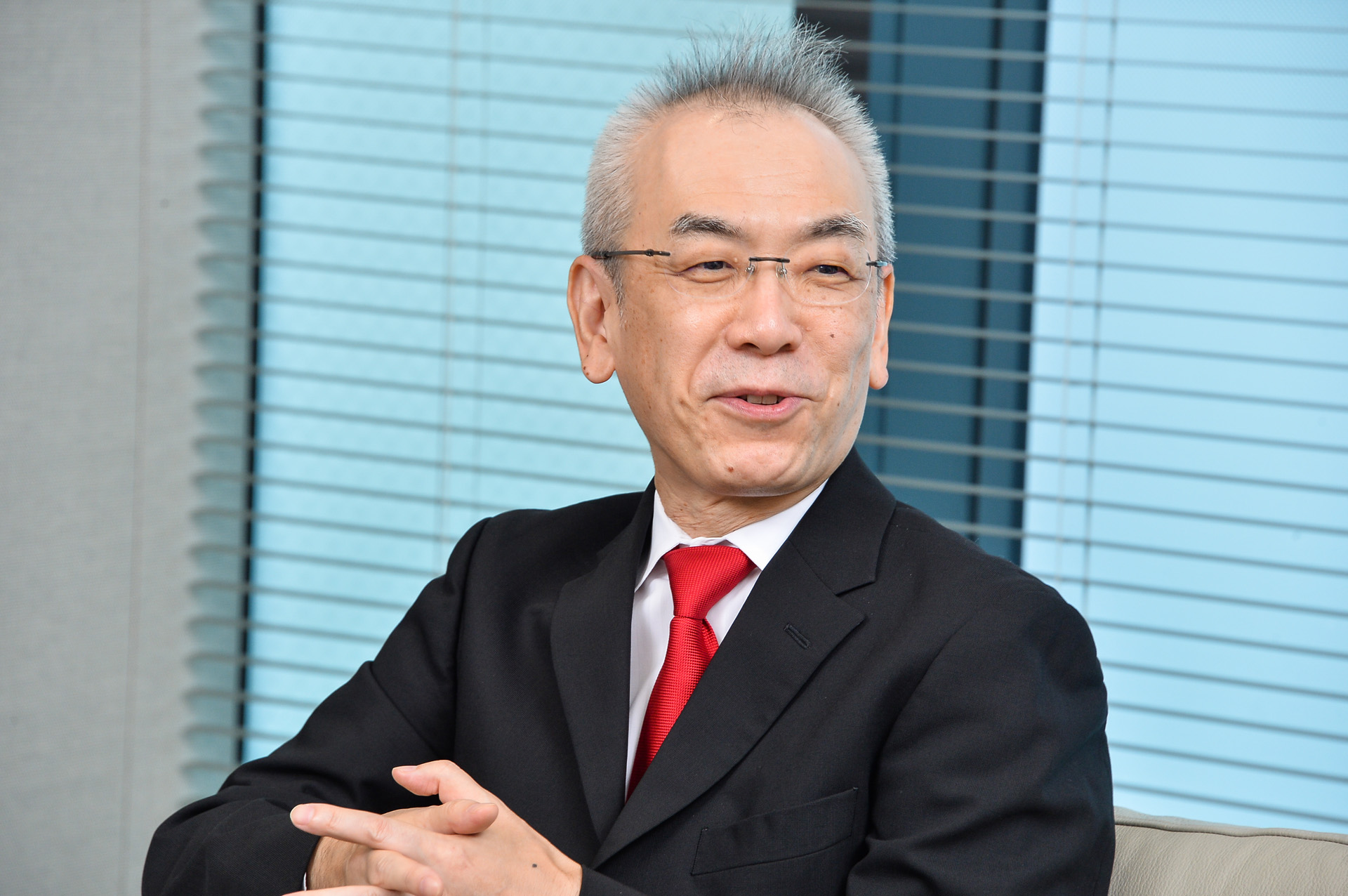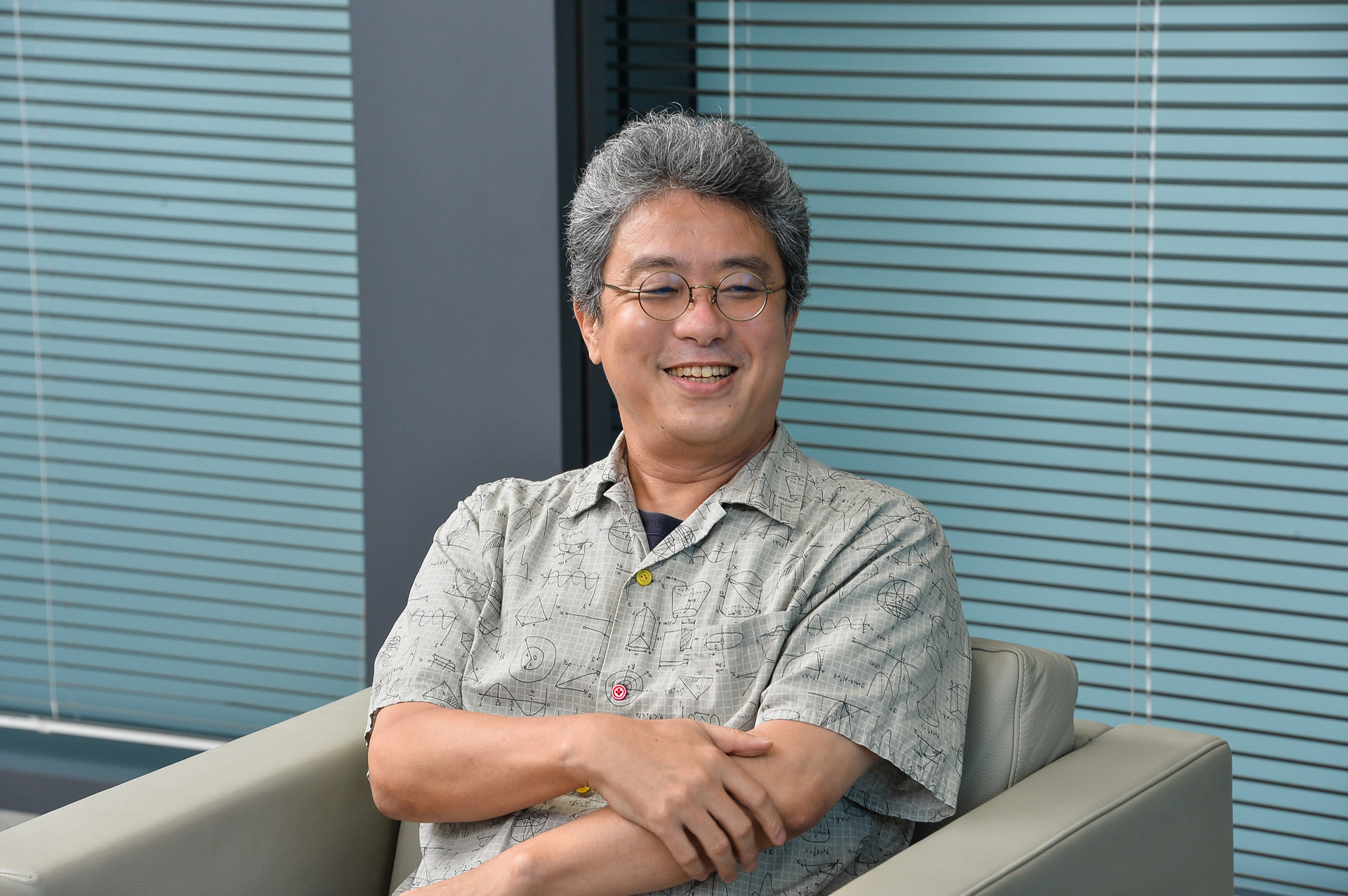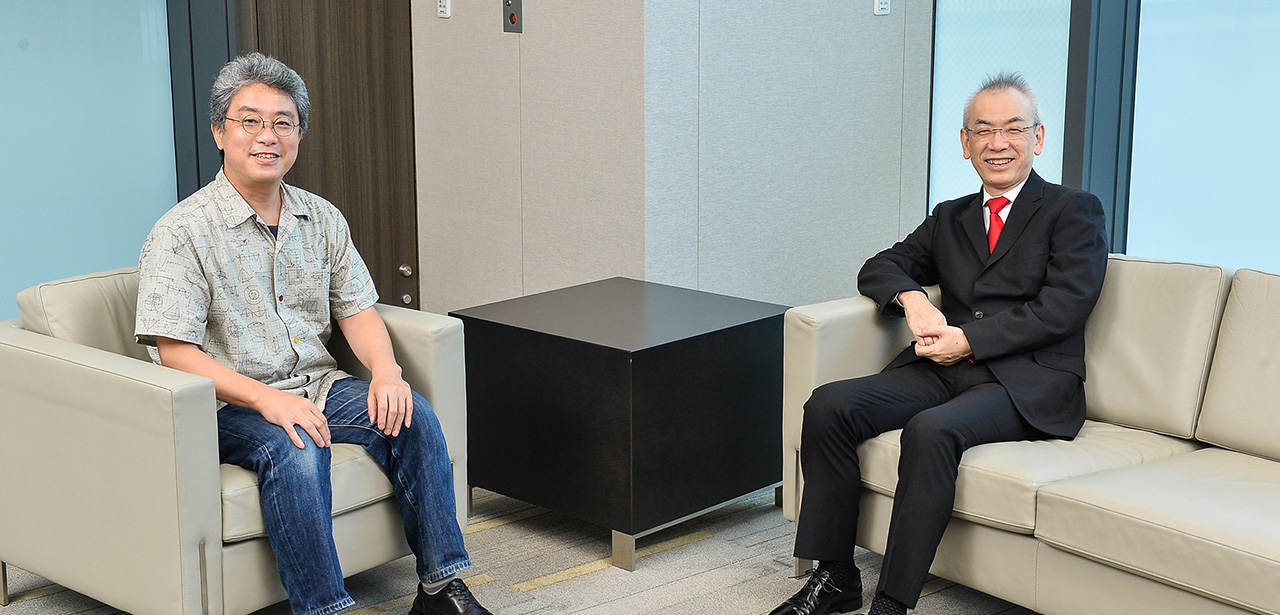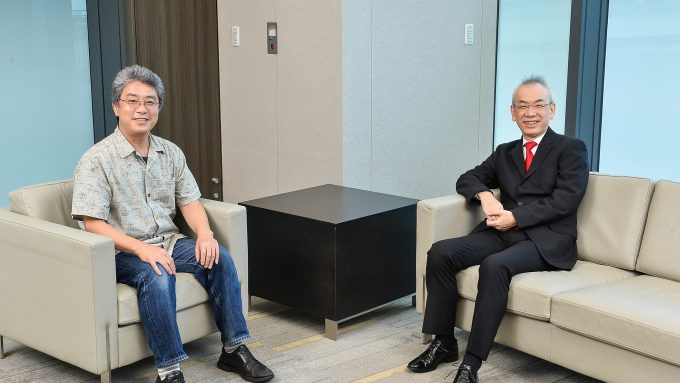“WE DISCUSS VANA’DIEL” is a series of conversations between Producer Matsui and special guests who are familiar with FINAL FANTASY XI (FFXI).
For our sixth guest, we invited Akitoshi Kawazu, the General Director of the SaGa series, who has been actively developing games since when the company was still known as Square. As Producer Matsui’s senior both in university and game development, what were his thoughts on FFXI? We began this four-part conversation by talking about how Mr. Kawazu joined the company.

Square Enix General Director of the SaGa series, who has been involved with the scenario, direction, and production of the series beginning with Makai Toushi SaGa* and Romancing SaGa. He has also been involved with the FINAL FANTASY (FF) series as a Game Designer in the original game and FFII, and as the Executive Producer of FFXII. He was also Producer Matsui's senior when they were enrolled at Tokyo Institute of Technology.
* Makai Toushi SaGa was released as The Final Fantasy Legend in North America.
Stumbling upon a fate-changing job advertisement
- Matsui
I’d never properly confirmed this and would like to take this opportunity to ask, but you’ve been at Square (as the company was formerly known) since they were working on the original FINAL FANTASY game, haven’t you?
- Kawazu
That’s right, I’ve been with the company since the first game.
- Matsui
That’d mean you’ve been with the company for nearly 35 years. Would you mind telling me again about how you joined Square at the time?
- Kawazu
There isn’t a whole lot to say about it.
After I dropped out of university, I was desperate to find work and just happened to find a listing by Square in a recruitment magazine. I was looking for a job at a game company at the time, but most companies like Namco (as they were formerly known) and Sega were only hiring fresh graduates from universities and trade schools, and even part-time positions were sparse. - Matsui
That’s how it was when I was searching for a job too.
- Kawazu
In the midst of that, I happened to see that Square was hiring, but my impression of them at the time was like, “Square, huh? I think I’ve heard of them before…” I think it was around when Suisho no Dragon* had just been released, which was that game with illustrations by Mr. Gen Sato*, and my knowledge of Square was pretty much limited to a commercial I’d seen for the game.
* Suisho no Dragon (which translates to “Dragon of Crystal”) is an adventure game released by Square for the Family Computer Disk System in 1986. The game features music composed by Nobuo Uematsu.* Gen Sato is a keyframe animator and animation quality director known for his work on numerous Japanese anime.
So I called Square and they replied, “Sorry, we’re no longer recruiting.” But for whatever reason, they asked me to hold for a minute, and came back asking, “Could you send us your resume after all?”
I sent in my resume via priority mail, and a few days later, I received a reply asking me to come in for an interview. - Matsui
Maybe someone was listening in on the call and said, “Wait! Have him send in his resume!” (laughs) If they’d simply hung up after telling you, “Sorry, we’re no longer recruiting,” then you wouldn’t have ended up at Square.
- Kawazu
That might be true. (laughs)
* Hiromichi Tanaka, original producer of FFXI.* Apple II is a personal computer released by Apple in 1977, one of the first to include features such as a built-in monitor and keyboard.
At my interview, I met Mr. Tanaka* who asked me things like, “You mentioned you own an Apple II*, what do you use it for?” After that sort of exchange went on for a bit, he finally told me, “I think you’re good to join the company.”
One thing I also remember is Mr. Tanaka mentioning, “Do you have a girlfriend? Once we enter game development, you won’t have any time to go out with anyone.” Asking that sort of thing at an interview nowadays would be a problem, by the way. (laughs) - Matsui
It’s illegal to ask about someone’s personal life at a job interview nowadays.
- Kawazu
But it can get really difficult to see people outside of work when things get really busy, so I do think it was valuable advice.

- Matsui
You mentioned you were looking to work at a game company. Were you always interested in working in the game industry?
- Kawazu
No, it wasn’t always like that. After all, I was already a part-time writer for a magazine called Beep*.
* Beep is a Japanese magazine by Nihon SoftBank (now known as SoftBank), which began publication in 1984 and predominantly featured console games during an era where many game magazines focused on computer games.* King’s Knight is a game released in 1986 which combined elements of shooting games and role-playing games.* Cruise Chaser Blassty is a role-playing game released in 1986.* Tabletop role-playing games (TRPGs) are role-playing games that progress based on a rulebook and spoken events. In Japan, these are often referred to as “table-talk role-playing games” instead.
To tell the truth, I actually knew a few other games by Square, like King’s Knight* and Cruise Chaser Blassty*, but I’d completely forgotten about them and only remembered Suisho no Dragon. (laughs)
On the other hand, I enjoyed TRPGs* like Dungeons & Dragons and spent a lot of time playing games on the Apple II, so in addition to possibly working as a writer, I did have some desire to make games if I ever had the opportunity. That being said, I never thought it’d ever happen.
In spite of that, I found Square’s job advertisement, so it really was quite the coincidence. If it wasn’t for that, Romancing SaGa may have never come into existence, though someone else may have ended up making something similar. It’s almost like something was pulling all of you to work at Square, seeing as how Mr. Kitase* and Mr. Matsui also went through a similar experience. It’s truly interesting how all these people with different talents joined the company one after another, almost like party members in an RPG.
* Yoshinori Kitase, Brand Manager of the FF series. See #5 Yoshinori Kitase Part 1.- Matsui
Well, many of those instances were through job advertisements. (laughs)
Backtracking a little, Mr. Kawazu was Mr. Matsui’s senior at Tokyo Institute of Technology. How did you two know each other back then?
- Matsui
We were both part of the science fiction club.
- Kawazu
Not that we did much research on science fiction. (laughs)
We did have some activities like reading books and creative projects, but most of our time was spent playing games, which became especially noticeable with our generation. - Matsui
There were loads of board games and such in our clubroom. As for TRPGs, some of our members were dungeon masters, and we’d play on Friday evenings.
- Kawazu
By the way, what made you join the science fiction club?
- Matsui
An upperclassman invited me. There was an assembly at the university where we had to introduce ourselves, and I’d mentioned that I was looking for a club with creative activities, so I ended up getting invited by an upperclassman in the science fiction club.
What was your impression of Mr. Kawazu back then?
- Matsui
Mr. Kawazu seemed like one of the ringleaders, which was also true with other members that seemed to be in the same year as him.
From a first year university student’s perspective, the fourth years seem like grown-ups. There were even some members who had a day job and only dropped by the clubroom to visit. So the club’s members ranged between those who only just graduated high school and those who were already working.
- Matsui
Although I’d been playing board games since high school, there was a “grown-up” atmosphere when the upperclassmen played, and I thought to myself, “Man, what did I get myself into?”
- Kawazu
Our club produced a self-published magazine about every year, so everyone was encouraged to write a short story. Did you write any short stories for the club, Mr. Matsui?
- Matsui
I did, about twice or so. They weren’t science fiction at all though. (laughs wryly)
Mr. Kawazu, do you remember when Mr. Matsui first joined the club?
- Kawazu
I don’t really remember when he joined, but I do remember playing video games, TRPGs, and mahjong together. (laughs)
The truth behind Mr. Kawazu’s request
During our interview with Mr. Kitase, Mr. Matsui mentioned how you’d told him, “Please don’t come to Square.” Could you tell us the reason behind that?
- Kawazu
Was it when you asked me for job searching advice?
- Matsui
Yes, I’d asked what it was like in the game industry, and you told me about it. But then you said, “But don’t come to Square, it’ll make things harder for me.”
- Kawazu
If anything, I didn’t want anyone I knew to join the company.
I grew up in a rural area and went to a local school until junior high, attended a high school in the city, then finally moved to Tokyo for university. Each time, I found myself in an environment where no one knew what I was like before. So when I was working at Square as a “brand-new Kawazu,” I wasn’t all that happy to work in the same company as someone who knew the old me from my university days. - Matsui
But I ended up joining Square, though I did feel apologetic to Mr. Kawazu. As he mentioned earlier, other than Square, many companies were only hiring new graduates. The game planner role was especially limited to experienced recruits, so I was very thankful that Square was welcoming anyone.

What was it like when you first joined Square, Mr. Kawazu?
- Kawazu
Back then, Square was mostly focused on developing computer games, and it was completely different from how it is today.
* Hironobu Sakaguchi, one of the founders of the FF series.* Kazuhiko Aoki, game designer for FFIII and other titles.* Koichi Ishii, original director of FFXI.
In a computer game company, the programmers hold a lot of power. After all, there were only a handful of game planners, whereas there were simply way more programmers. The game planners were pretty much just Mr. Sakaguchi*, Mr. Tanaka, and Mr. Aoki*, while Mr. Ishii* was still just a part-timer.
An entire floor of our building was dedicated to the programmers, where all of them were working side-by-side. As for me, I felt like I had no business being on that floor and didn’t set foot in there. Was it uncommon for game planners and programmers to communicate directly back then?
- Kawazu
When I joined the FF team, the first programmer I met was Nasir*, and I didn’t speak with the Japanese programmers very often. At some point, we were joined by Mr. Adachi* and Mr. Yoshii*, but working with them was completely different from working with Nasir.
* Nasir Gebelli, programmer for FF through FFIII.* Keitaro Adachi, programmer for Makai Toushi SaGa and other works.* Kiyoshi Yoshii, battle programmer for FFIII through FFVI and other works.
Of course, communicating with Nasir still involved writing out the specifications and explaining them when he asked for clarification, but I had a rough time talking to him in English. I’d end up telling him, “Please just do it this way,” and he’d be frustrated too, since I wasn’t able to communicate my intentions to him. In the end, Nasir would basically say, “I don’t understand your reasoning behind this, but I’ll make it work as specified. I don’t know if it’ll work the way you intended, so be sure to check it thoroughly.” - Matsui
I see, so something like that happened.
- Kawazu
Because of that, although I was writing specifications for Nasir with my sloppy English skills at first, at some point Nasir said, “I don’t really understand the battle-related aspects, so please assign them to a Japanese programmer,” and he ended up working on non-battle aspects like making the airship fly.
After Mr. Yoshii began handling the battle-related aspects, I no longer had to go through the trouble of writing the specifications in English. Prior to that, Mr. Yoshii was also programming based on my half-English specification documents, so I felt bad that I was causing the two of them so much trouble. (laughs wryly) - Matsui
In the specification documents I was referencing for FFIV, chocobos were called “ostriches” and the movement-related specifications were written in English for some mysterious reason, but now I know why.
- Kawazu
I think Mr. Tanaka made those. The specifications I wrote in English were explanations for Nasir regarding battle-related aspects and data structures like, “This bit is for equipment, and this bit is for their attributes,” and “You can’t wear two pieces of armor.” Mr. Yoshii would then decipher that document to do his part of the work.
- Matsui
Mr. Tanaka mentioned he had no memory of it.
- Kawazu
I also have the specification documents where chocobos are called “ostriches,” but perhaps Mr. Sakaguchi rewrote them for explanation purposes.
When I previously spoke with Mr. Tanaka, he’d mentioned, “Mr. Kawazu is pretty mean. If a programmer asks, ‘Why is this feature like this?’ he’s the kind of person who says, ‘You don’t need to understand, just follow the instructions.’” But I guess that was Mr. Tanaka’s way of exaggerating things, and in reality, there was the hurdle of having to communicate in English.
- Kawazu
No, in the past, I probably would’ve replied like that to Japanese programmers too. (laughs wryly)
- everyone
(laughs)
- Matsui
By the way, who taught you game design?
- Kawazu
Mr. Tanaka was my role model in everything related to game planning, and the way I wrote specification documents also mimicked what he’d written.
With programming, my teacher was Mr. Adachi. Mr. Adachi was the type of person to create features by himself, so I used his way of thinking as a foundation when learning how to communicate ideas to programmers. Sounds like pretty much everyone from the old Square was Mr. Tanaka’s disciple.
- Matsui
The way I see it, Mr. Tanaka was the father figure at Square, whereas Mr. Adachi was the mother figure. (laughs)
- Kawazu
Programs had to be written in assembly* but there weren’t any manuals back then, and even if there were, I imagine they would’ve been very expensive. So rather than learning programming from theory, I’d ask Mr. Tanaka, “Why does it do this?” and he’d be like, “It works if you do it this way.”
* Assembly language refers to “low-level” programming languages which are easier for computers to execute, as opposed to “high-level” programming languages such as C, Java, or PHP, which are designed for human readability. - Matsui
I often heard stories from back then but never in great detail, so I’m having a lot of fun hearing this.
Mr. Kawazu, do you remember when Mr. Matsui joined the company in 1990?
- Kawazu
As I mentioned earlier, I didn’t like having someone in the company that knew the old me, so I kept my distance at first. (laughs)
- Matsui
But you did treat me to meals before payday. That was like a lifeline for me. (laughs)
- Kawazu
There were times like that, weren’t there? (laughs)
At some point, we were thinking about expanding the team, and I considered bringing in Mr. Matsui. Since we were from the same university, I knew he’d be familiar with mathematics and the fundamentals of creating data. We’d also played games together, so I knew I could talk to him in technical terms and figured he’d be a great addition to the team. But Mr. Sakaguchi said he’d put Mr. Matsui into the FF team, and that’s where he ended up. Were there any opportunities for the two of you to work together after that?
- Matsui
We worked together for Romancing SaGa 2.
- Kawazu
We didn’t have any other opportunities to work together until then.
* Nobuyuki Inoue, overworld map and effects designer for Romancing SaGa.* SaGa 2: Hihou Densetsu was released as Final Fantasy Legend II in North America.
Which reminds me, Mr. Inoue* joined our team around the time I was hoping to add Mr. Matsui. I think I worked with him for SaGa 2: Hihou Densetsu* and Romancing SaGa. - Matsui
Mr. Inoue was in the FFIV team when I joined the company, and we talked about doing our best as fellow members in objection of Active Time Battle (ATB).
* Active Time Battle is a battle system implemented in FFIV which introduced time-based elements and was atypical of turn-based games at the time. Each character has a Speed stat which determines the waiting time between actions. Was that like a faction or something?
- Matsui
It wasn’t really a faction, but some of us wanted to maintain the careful decision-making gameplay of command-based battles. ATB is fun, but I’m sure there were players who found it difficult, and that sort of debate is what led to the implementation of the Wait option.
But before I knew it, Mr. Inoue was moved to another team. How did you feel when you finally got to work with Mr. Kawazu?
- Matsui
By that time, I already knew what sort of work Mr. Kawazu did, but the Battle team within the SaGa team already had Mr. Koizumi* and I wasn’t sure how I could be of help.
* Kyoji Koizumi, battle designer for Romancing SaGa 2 and other works.
I believe it was SaGa Frontier, where I ended up designing the event script system in a really maniacal way because I knew it was Mr. Kawazu’s project. The design had all sorts of codes in the regular text so you could tweak all sorts of things, but that ended up making things really hard for the Localization team. My intention was to allow Mr. Kawazu a lot of freedom in event creation, but I learned that being too niche with designs can also lead to mistakes.




